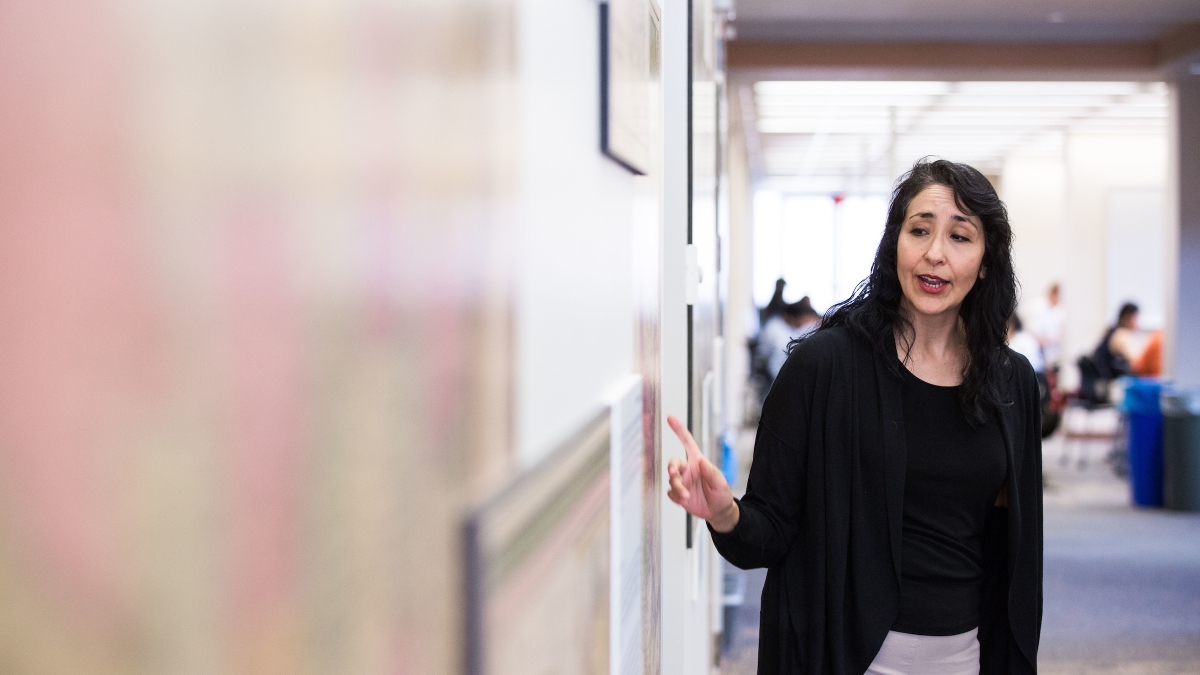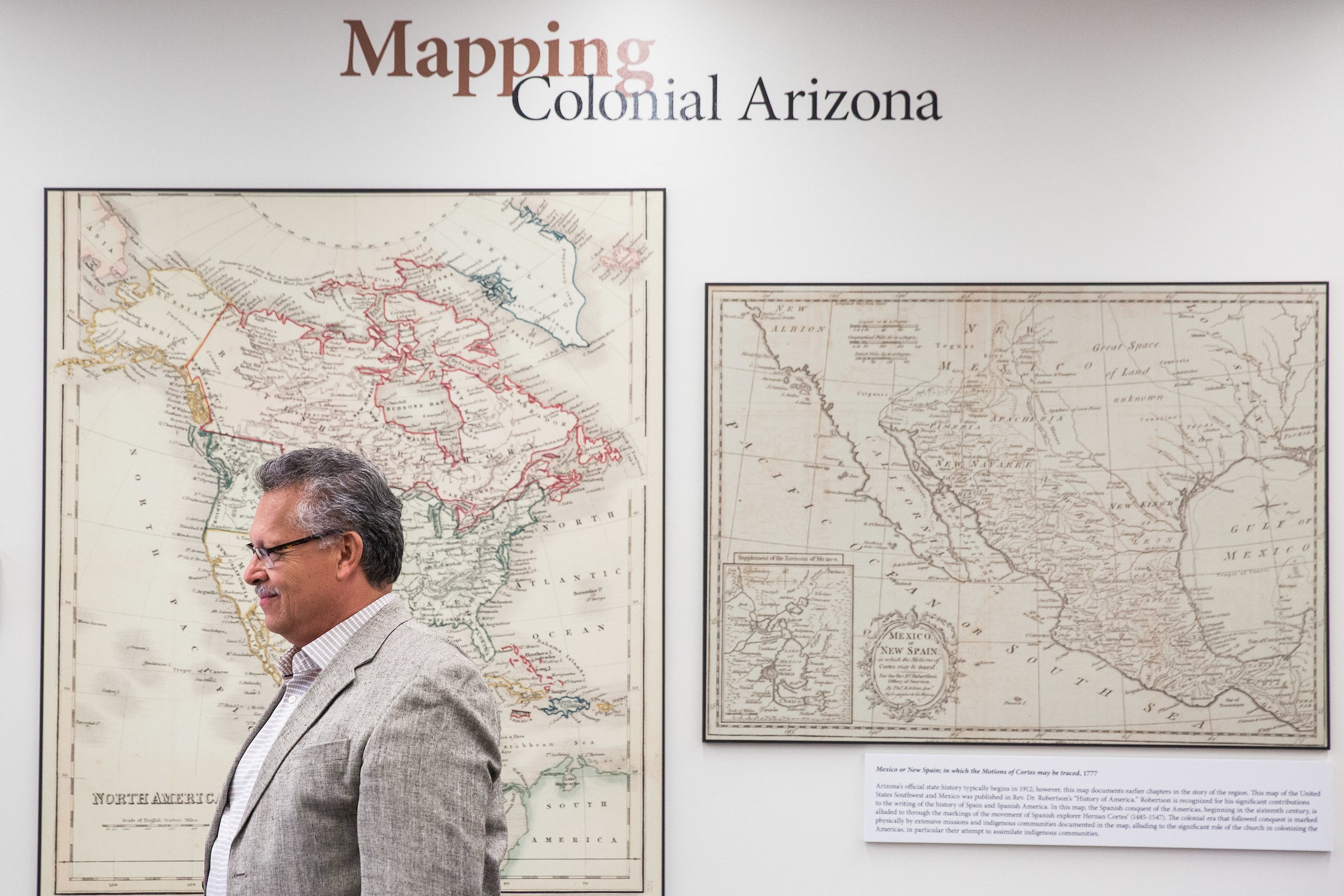Rare ASU map collection reveals truths about history of American Southwest

An exhibit of rare maps at ASU is challenging assumptions about the history of the American Southwest by showing a range of details that conflict depending on what was being documented and who was doing the work, a curator with ASU’s School of Transborder Studies said.
“The maps show you things you didn’t expect or even know,” said Theresa Avila, co-curator of “Greater Arizona: Mapping Place, History and Transformation.” “For instance, that this area belonged to France at one point — or at least France thought so.
“These maps are documents; they’re historical; they’re produced by the most learned of their time. But there’s still a lot of errors and problems with them. … History is not only what we know, but what we don’t know. So these maps help us to learn what we don’t know.”
The collection will be on display at Hayden Library on ASU’s Tempe campus through May 19. Dating from the 16th to the 19th centuries, the maps document everything from peoples to borders to geographical features, and were created by a number of nations, including France, Great Britain and Holland — all that variation reveals portions of history that in some cases have been ignored.
A group of students recently toured the collection as research for a project looking at migration to the U.S. through Latin American countries. The maps were indeed useful for their research, but Avila said she “was also able to point out the migration from Europe to the Americas first. If we’re going to really talk about migration, who’s migrating where?”
All of the maps in the Hayden exhibit come from the School of Transborder Studies Simon Burrow Collection. Burrow, a global industrialist, accumulated the collection of more than 100 original maps and 200 books over nearly three decades out of a desire to better understand the U.S. and Mexico borderlands where he conducted business. He donated it all to the school in 2012, where it is on permanent display in the Interdisciplinary B buildingBurrow will be in attendance at a May 4 celebration to honor university donors from 4-6 p.m. at Hayden Library..
Avila calls Burrow’s maps “key maps,” because they are key in understanding truths about the history of the Southwest. For example, one map, created by the U.S. government in 1839, features the independent “Republic of Texas.” At the time, however, ownership of that land was in dispute between the U.S. and Mexico, which did not acknowledge Texas’ declaration of independence.
“This map in particular really highlights a very key moment … in the revision of history,” Avila said. “Texas was never a republic. But it’s still a very strong narrative in the U.S. mind. We feel that when the Alamo happened, we were justified. And yet, when you read the narrative of this map and the way Texas was taken over, we weren’t really justified in taking this land over hostilely.”
School of Transborder Studies Director Alejandro Lugo has helped curate a map exhibition at Hayden Library that shows how Arizona and the Southwest have been depicted over hundreds of years. Photo by Deanna Dent/ASU Now
The images pasted directly onto the walls in Hayden are digital print reproductions of the actual maps, magnified so viewers can see the finer details. Some of the maps have been modified, like the one from 1866 marking the gold, copper and silver deposits in the region. Old photos of miners are affixed to the map at the location where they were taken.
“In an effort to remember and connect the different phases of development of Arizona” reads the accompanying plaque, “this map is paired … with Arizona mining history that is typically recognized as the state’s official history. Bringing both elements together allows for inclusion of communities typically omitted from Arizona history...”
The exhibit also features photos of the border region taken by School of Transborder Studies Director Alejandro Lugo, who co-curated the collection with Avila. Along the ramp leading up to the main level of the exhibit are photos of the existing U.S.-Mexico border fence. Along the bottom of a map from 1774 of the Spanish missions are photos of the missions as they stand today, taken by Lugo in 2016.
Pairing the past with the present in such a way makes the information more “inviting and accessible,” Lugo said. “It helps them to think about the longer history of the place and how we are a part of the landscape today.”
Most importantly, agree Lugo and Avila, the exhibit paints a more accurate picture of the history of the Southwest, and Arizona in particular.
On the state’s website, Avila said, history begins in 1912. “This collection reveals that this place — that Arizona — has a much longer story, and a much more diverse history than has been presented to us.”
Top photo: Theresa Avila, of ASU's School of Transborder Studies, shows how maps began to omit Native American tribes following the Indian Removal Act in 1830 inside the exhibition "Greater Arizona: Mapping Place, History and Transformation" in the Hayden Library on Tuesday. The project will be on display through May 19. Photo by Deanna Dent/ASU Now
More Arts, humanities and education

ASU's Pen Project helps unlock writing talent for inmates
It’s a typical Monday afternoon and Lance Graham is on his way to the Arizona State Prison in Goodyear.It’s a familiar scene. Graham has been in prison before.“I feel comfortable in prison because of…

Phoenix civil rights activists highlighted in ASU professor’s latest book
As Phoenix began to grow following WWII, residents from other parts of the country moving to the area often brought with them Jim Crow practices. Racism in the Valley abounded, and one family at…

Happy mistake: Computer error brings ASU Online, on-campus students together to break new ground in research
Every Thursday, a large group of students gathers in the Teotihuacan Research Laboratory (TeoLab) in the basement of the School of Human Evolution and Social Change building on Arizona…


